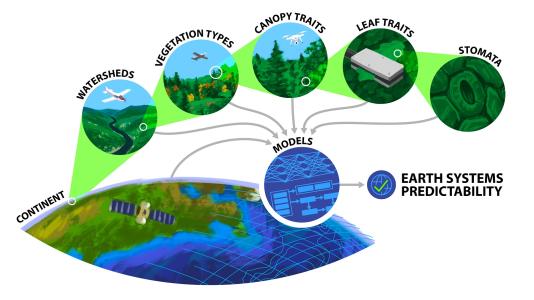Revolutionary environmental artificial intelligence infrastructure detailed in new report
Report gives new insight on predicting climate

The use of artificial intelligence (AI) to help collect, understand and analyze large sets of information has the potential to revolutionize our ability to observe, understand and predict processes in the Earth’s systems.
Researchers and scientists are working together to apply AI and modeling techniques such as machine learning (ML) to advance Earth and environmental science. Specifically, a group of scientists and experts aims to integrate modern technology in the work of Earth system models, observations and theory — as well as to provide computational capabilities that can deliver speed, accuracy and more-informed, agile decision-making.
In a collaborative effort between the U.S. Department of Energy’s (DOE) Office of Biological and Environmental Research (BER) and DOE’s Advanced Scientific Computing Research program, as well as with community experts, the Artificial Intelligence for Earth System Predictability (AI4ESP) workshop was held from October through December 2021. The five-week virtual workshop explored the challenges and development of an infrastructure that would best integrate a combination of technological capabilities and human activities in the field and laboratories with computational resources. BER developed the process as the “Model-Experiment” paradigm, or ModEx.
“Effective improvements to Earth system predictability require radical advancements across the ModEx environment. This workshop offered a cross-discipline and cross-mission opportunity for the scientific and application communities to collaborate towards the understanding of the advancements needed,” said AI4ESP lead Nicki Hickmon, associate director for operations for DOE’s Atmospheric Radiation Measurement Office of Science user facility at DOE’s Argonne National Laboratory.
According to a newly released report summarizing the AI4ESP workshop, the event brought together more than 700 participants from both the private and public sectors, with representatives from the Earth and environmental sciences, computing and AI. Together, about 100 experts designed the workshop based on 156 white papers provided by 640 authors from 112 institutions around the world.
Information was narrowed down to 17 topics related to the integrative water cycle and extreme weather phenomena within that cycle. Experts discussed nine focal points related to Earth system predictions, including sessions involving hydrology, watershed science and coastal dynamics; atmosphere, land, oceans and ice; and climate variability and extremes. Throughout the sessions, participants explored the potential of AI to unlock scientific discoveries using tools such as neural networks, knowledge-informed machine learning, AI architectures and co-design.
In each session, researchers identified challenges that support the need for revolutionized AI technology and infrastructure that can be applied to manage complex work in the environmental science field.
“We need new AI methodologies that incorporate process understanding and respect physical laws to make predictions of Earth system behavior scalable, trustworthy and applicable under future climate regimes,” said Charu Varadharajan, a research scientist at DOE’s Lawrence Berkeley National Laboratory who leads the laboratory’s Earth AI & Data Program Domain. “This workshop is unique in discussing how AI could improve models, observations and theory incorporating DOE’s ModEx approach.”
“The workshop and report allowed us to develop 2-, 5- and 10-year goals for the integrative framework development for each focal point. We also identified priorities for Earth science, computational science, and programmatic and cultural changes that would encompass AI4ESP’s mission,” Varadharajan added.
Experts developed a comprehensive list of opportunities where AI research and development can help with some of the greatest challenges facing Earth science. These challenges include managing and analyzing large sets of data to enhance the ability to observe and predict extreme events and foster the integration of human activities into theory and models.
“One of the most exciting opportunities in modeling is the development of new hybrid models that incorporate both process-based and ML-based modules,” said Forrest Hoffman, lead for the Computational Earth Sciences group at DOE’s Oak Ridge National Laboratory. “These modeling frameworks enable incorporation of data about poorly understood processes that can improve the accuracy and often result in improved computational performance for Earth system models, enabling more simulations and analysis to be conducted within given resource limits.”
Workshop participants also identified several priorities to tackle computational challenges — including advancements in both AI and ML, algorithms, data management and more. The result of those priorities can aid in developing a technology infrastructure that is efficient, accurate, strategic and convenient, and further reaches across resources.
There is also a need for programmatic and cultural changes to support a more cohesive mission across various scientific and government agencies, as well as a trained workforce that can successfully integrate technology into their humanistic research and activities. The experts identified solutions that would include AI research centers specific to environmental science, frameworks that enable shared services across various communities, and ongoing training and support missions.
The 2021 AI4ESP workshop participants continue to discuss community computational activities, including those from the American Geophysical Union and American Meteorological Society. Stay tuned for additional workshops and meetings in the near future — more collaborations, engagements and framework development will continue to further the AI4ESP mission.
Argonne National Laboratory seeks solutions to pressing national problems in science and technology by conducting leading-edge basic and applied research in virtually every scientific discipline. Argonne is managed by UChicago Argonne, LLC for the U.S. Department of Energy’s Office of Science.
The U.S. Department of Energy’s Office of Science is the single largest supporter of basic research in the physical sciences in the United States and is working to address some of the most pressing challenges of our time. For more information, visit https://energy.gov/science.